2014 NISSAN GT-R warning
[x] Cancel search: warningPage 210 of 354
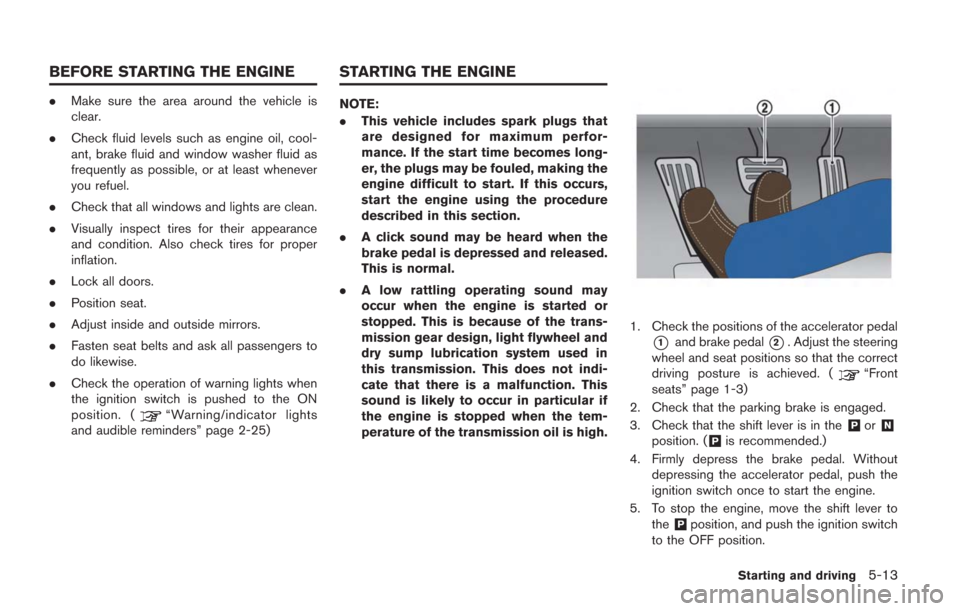
.Make sure the area around the vehicle is
clear.
. Check fluid levels such as engine oil, cool-
ant, brake fluid and window washer fluid as
frequently as possible, or at least whenever
you refuel.
. Check that all windows and lights are clean.
. Visually inspect tires for their appearance
and condition. Also check tires for proper
inflation.
. Lock all doors.
. Position seat.
. Adjust inside and outside mirrors.
. Fasten seat belts and ask all passengers to
do likewise.
. Check the operation of warning lights when
the ignition switch is pushed to the ON
position. (
“Warning/indicator lights
and audible reminders” page 2-25)
NOTE:
. This vehicle includes spark plugs that
are designed for maximum perfor-
mance. If the start time becomes long-
er, the plugs may be fouled, making the
engine difficult to start. If this occurs,
start the engine using the procedure
described in this section.
. A click sound may be heard when the
brake pedal is depressed and released.
This is normal.
. A low rattling operating sound may
occur when the engine is started or
stopped. This is because of the trans-
mission gear design, light flywheel and
dry sump lubrication system used in
this transmission. This does not indi-
cate that there is a malfunction. This
sound is likely to occur in particular if
the engine is stopped when the tem-
perature of the transmission oil is high.
1. Check the positions of the accelerator pedal
*1and brake pedal*2. Adjust the steering
wheel and seat positions so that the correct
driving posture is achieved. (
“Front
seats” page 1-3)
2. Check that the parking brake is engaged.
3. Check that the shift lever is in the
&Por&N
position. (&Pis recommended.)
4. Firmly depress the brake pedal. Without depressing the accelerator pedal, push the
ignition switch once to start the engine.
5. To stop the engine, move the shift lever to the
&Pposition, and push the ignition switch
to the OFF position.
Starting and driving5-13
BEFORE STARTING THE ENGINE STARTING THE ENGINE
Page 211 of 354
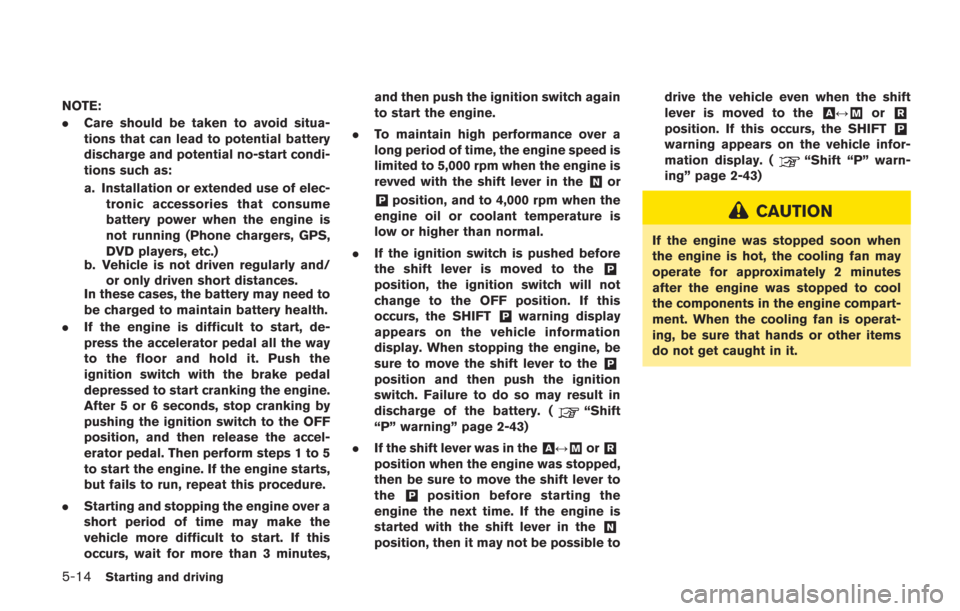
5-14Starting and driving
NOTE:
.Care should be taken to avoid situa-
tions that can lead to potential battery
discharge and potential no-start condi-
tions such as:
a. Installation or extended use of elec-
tronic accessories that consume
battery power when the engine is
not running (Phone chargers, GPS,
DVD players, etc.)
b. Vehicle is not driven regularly and/
or only driven short distances.
In these cases, the battery may need to
be charged to maintain battery health.
. If the engine is difficult to start, de-
press the accelerator pedal all the way
to the floor and hold it. Push the
ignition switch with the brake pedal
depressed to start cranking the engine.
After 5 or 6 seconds, stop cranking by
pushing the ignition switch to the OFF
position, and then release the accel-
erator pedal. Then perform steps 1 to 5
to start the engine. If the engine starts,
but fails to run, repeat this procedure.
. Starting and stopping the engine over a
short period of time may make the
vehicle more difficult to start. If this
occurs, wait for more than 3 minutes, and then push the ignition switch again
to start the engine.
. To maintain high performance over a
long period of time, the engine speed is
limited to 5,000 rpm when the engine is
revved with the shift lever in the
&Nor
&Pposition, and to 4,000 rpm when the
engine oil or coolant temperature is
low or higher than normal.
. If the ignition switch is pushed before
the shift lever is moved to the
&P
position, the ignition switch will not
change to the OFF position. If this
occurs, the SHIFT
&Pwarning display
appears on the vehicle information
display. When stopping the engine, be
sure to move the shift lever to the
&P
position and then push the ignition
switch. Failure to do so may result in
discharge of the battery. (
“Shift
“P” warning” page 2-43)
. If the shift lever was in the
&A↔&Mor&R
position when the engine was stopped,
then be sure to move the shift lever to
the
&Pposition before starting the
engine the next time. If the engine is
started with the shift lever in the
&N
position, then it may not be possible to drive the vehicle even when the shift
lever is moved to the
&A↔&Mor&R
position. If this occurs, the SHIFT&P
warning appears on the vehicle infor-
mation display. (“Shift “P” warn-
ing” page 2-43)
CAUTION
If the engine was stopped soon when
the engine is hot, the cooling fan may
operate for approximately 2 minutes
after the engine was stopped to cool
the components in the engine compart-
ment. When the cooling fan is operat-
ing, be sure that hands or other items
do not get caught in it.
Page 212 of 354
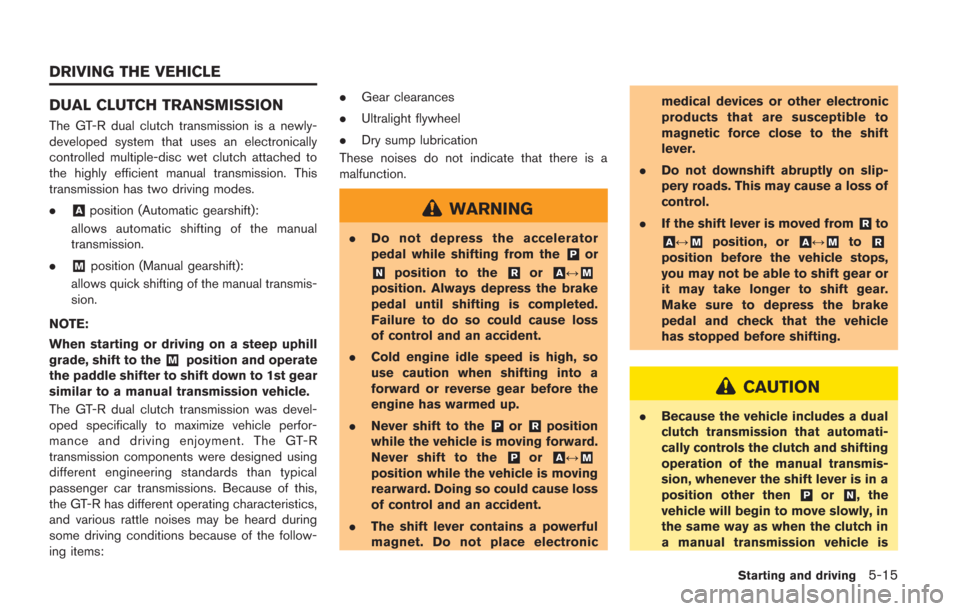
DUAL CLUTCH TRANSMISSION
The GT-R dual clutch transmission is a newly-
developed system that uses an electronically
controlled multiple-disc wet clutch attached to
the highly efficient manual transmission. This
transmission has two driving modes.
.
&Aposition (Automatic gearshift):
allows automatic shifting of the manual
transmission.
.
&Mposition (Manual gearshift):
allows quick shifting of the manual transmis-
sion.
NOTE:
When starting or driving on a steep uphill
grade, shift to the
&Mposition and operate
the paddle shifter to shift down to 1st gear
similar to a manual transmission vehicle.
The GT-R dual clutch transmission was devel-
oped specifically to maximize vehicle perfor-
mance and driving enjoyment. The GT-R
transmission components were designed using
different engineering standards than typical
passenger car transmissions. Because of this,
the GT-R has different operating characteristics,
and various rattle noises may be heard during
some driving conditions because of the follow-
ing items: .
Gear clearances
. Ultralight flywheel
. Dry sump lubrication
These noises do not indicate that there is a
malfunction.
WARNING
. Do not depress the accelerator
pedal while shifting from the&Por
&Nposition to the&Ror&A↔&M
position. Always depress the brake
pedal until shifting is completed.
Failure to do so could cause loss
of control and an accident.
. Cold engine idle speed is high, so
use caution when shifting into a
forward or reverse gear before the
engine has warmed up.
. Never shift to the
&Por&Rposition
while the vehicle is moving forward.
Never shift to the
&Por&A↔&M
position while the vehicle is moving
rearward. Doing so could cause loss
of control and an accident.
. The shift lever contains a powerful
magnet. Do not place electronic medical devices or other electronic
products that are susceptible to
magnetic force close to the shift
lever.
. Do not downshift abruptly on slip-
pery roads. This may cause a loss of
control.
. If the shift lever is moved from
&Rto
&A↔&Mposition, or&A↔&Mto&R
position before the vehicle stops,
you may not be able to shift gear or
it may take longer to shift gear.
Make sure to depress the brake
pedal and check that the vehicle
has stopped before shifting.
CAUTION
.Because the vehicle includes a dual
clutch transmission that automati-
cally controls the clutch and shifting
operation of the manual transmis-
sion, whenever the shift lever is in a
position other then
&Por&N, the
vehicle will begin to move slowly, in
the same way as when the clutch in
a manual transmission vehicle is
Starting and driving5-15
DRIVING THE VEHICLE
Page 219 of 354
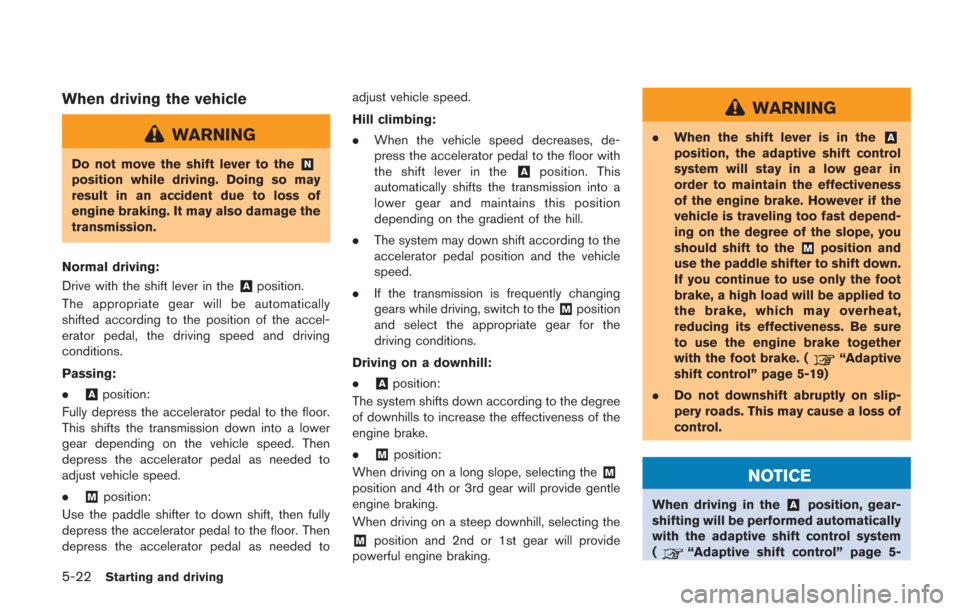
5-22Starting and driving
When driving the vehicle
WARNING
Do not move the shift lever to the&N
position while driving. Doing so may
result in an accident due to loss of
engine braking. It may also damage the
transmission.
Normal driving:
Drive with the shift lever in the
&Aposition.
The appropriate gear will be automatically
shifted according to the position of the accel-
erator pedal, the driving speed and driving
conditions.
Passing:
.
&Aposition:
Fully depress the accelerator pedal to the floor.
This shifts the transmission down into a lower
gear depending on the vehicle speed. Then
depress the accelerator pedal as needed to
adjust vehicle speed.
.
&Mposition:
Use the paddle shifter to down shift, then fully
depress the accelerator pedal to the floor. Then
depress the accelerator pedal as needed to adjust vehicle speed.
Hill climbing:
.
When the vehicle speed decreases, de-
press the accelerator pedal to the floor with
the shift lever in the
&Aposition. This
automatically shifts the transmission into a
lower gear and maintains this position
depending on the gradient of the hill.
. The system may down shift according to the
accelerator pedal position and the vehicle
speed.
. If the transmission is frequently changing
gears while driving, switch to the
&Mposition
and select the appropriate gear for the
driving conditions.
Driving on a downhill:
.
&Aposition:
The system shifts down according to the degree
of downhills to increase the effectiveness of the
engine brake.
.
&Mposition:
When driving on a long slope, selecting the
&M
position and 4th or 3rd gear will provide gentle
engine braking.
When driving on a steep downhill, selecting the
&Mposition and 2nd or 1st gear will provide
powerful engine braking.
WARNING
. When the shift lever is in the&A
position, the adaptive shift control
system will stay in a low gear in
order to maintain the effectiveness
of the engine brake. However if the
vehicle is traveling too fast depend-
ing on the degree of the slope, you
should shift to the
&Mposition and
use the paddle shifter to shift down.
If you continue to use only the foot
brake, a high load will be applied to
the brake, which may overheat,
reducing its effectiveness. Be sure
to use the engine brake together
with the foot brake. (
“Adaptive
shift control” page 5-19)
. Do not downshift abruptly on slip-
pery roads. This may cause a loss of
control.
NOTICE
When driving in the&Aposition, gear-
shifting will be performed automatically
with the adaptive shift control system
(
“Adaptive shift control” page 5-
Page 220 of 354
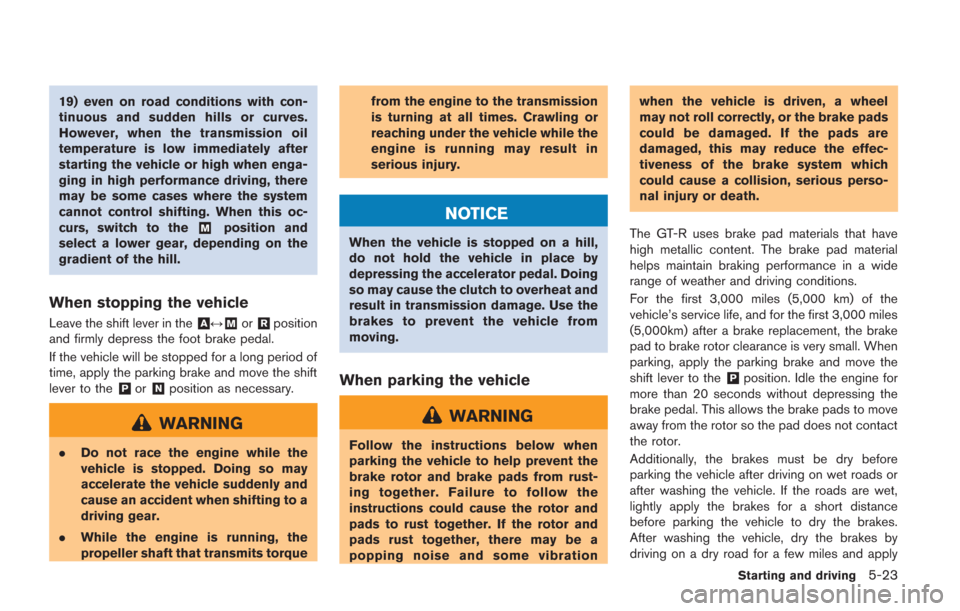
19) even on road conditions with con-
tinuous and sudden hills or curves.
However, when the transmission oil
temperature is low immediately after
starting the vehicle or high when enga-
ging in high performance driving, there
may be some cases where the system
cannot control shifting. When this oc-
curs, switch to the
&Mposition and
select a lower gear, depending on the
gradient of the hill.
When stopping the vehicle
Leave the shift lever in the&A↔&Mor&Rposition
and firmly depress the foot brake pedal.
If the vehicle will be stopped for a long period of
time, apply the parking brake and move the shift
lever to the
&Por&Nposition as necessary.
WARNING
. Do not race the engine while the
vehicle is stopped. Doing so may
accelerate the vehicle suddenly and
cause an accident when shifting to a
driving gear.
. While the engine is running, the
propeller shaft that transmits torque from the engine to the transmission
is turning at all times. Crawling or
reaching under the vehicle while the
engine is running may result in
serious injury.
NOTICE
When the vehicle is stopped on a hill,
do not hold the vehicle in place by
depressing the accelerator pedal. Doing
so may cause the clutch to overheat and
result in transmission damage. Use the
brakes to prevent the vehicle from
moving.
When parking the vehicle
WARNING
Follow the instructions below when
parking the vehicle to help prevent the
brake rotor and brake pads from rust-
ing together. Failure to follow the
instructions could cause the rotor and
pads to rust together. If the rotor and
pads rust together, there may be a
popping noise and some vibrationwhen the vehicle is driven, a wheel
may not roll correctly, or the brake pads
could be damaged. If the pads are
damaged, this may reduce the effec-
tiveness of the brake system which
could cause a collision, serious perso-
nal injury or death.
The GT-R uses brake pad materials that have
high metallic content. The brake pad material
helps maintain braking performance in a wide
range of weather and driving conditions.
For the first 3,000 miles (5,000 km) of the
vehicle’s service life, and for the first 3,000 miles
(5,000km) after a brake replacement, the brake
pad to brake rotor clearance is very small. When
parking, apply the parking brake and move the
shift lever to the
&Pposition. Idle the engine for
more than 20 seconds without depressing the
brake pedal. This allows the brake pads to move
away from the rotor so the pad does not contact
the rotor.
Additionally, the brakes must be dry before
parking the vehicle after driving on wet roads or
after washing the vehicle. If the roads are wet,
lightly apply the brakes for a short distance
before parking the vehicle to dry the brakes.
After washing the vehicle, dry the brakes by
driving on a dry road for a few miles and apply
Starting and driving5-23
Page 221 of 354
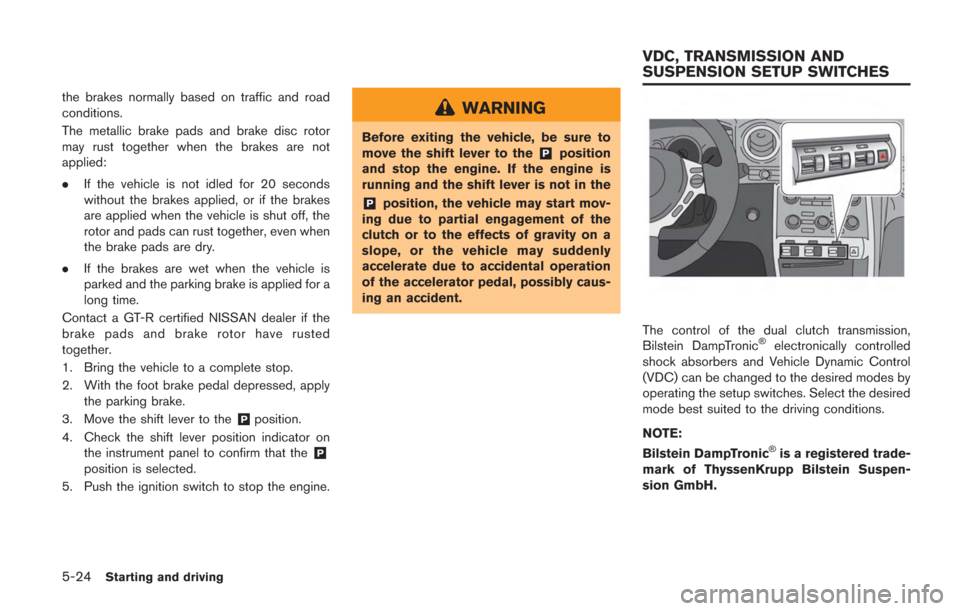
5-24Starting and driving
the brakes normally based on traffic and road
conditions.
The metallic brake pads and brake disc rotor
may rust together when the brakes are not
applied:
.If the vehicle is not idled for 20 seconds
without the brakes applied, or if the brakes
are applied when the vehicle is shut off, the
rotor and pads can rust together, even when
the brake pads are dry.
. If the brakes are wet when the vehicle is
parked and the parking brake is applied for a
long time.
Contact a GT-R certified NISSAN dealer if the
brake pads and brake rotor have rusted
together.
1. Bring the vehicle to a complete stop.
2. With the foot brake pedal depressed, apply the parking brake.
3. Move the shift lever to the
&Pposition.
4. Check the shift lever position indicator on the instrument panel to confirm that the
&P
position is selected.
5. Push the ignition switch to stop the engine.
WARNING
Before exiting the vehicle, be sure to
move the shift lever to the&Pposition
and stop the engine. If the engine is
running and the shift lever is not in the
&Pposition, the vehicle may start mov-
ing due to partial engagement of the
clutch or to the effects of gravity on a
slope, or the vehicle may suddenly
accelerate due to accidental operation
of the accelerator pedal, possibly caus-
ing an accident.
The control of the dual clutch transmission,
Bilstein DampTronic®electronically controlled
shock absorbers and Vehicle Dynamic Control
(VDC) can be changed to the desired modes by
operating the setup switches. Select the desired
mode best suited to the driving conditions.
NOTE:
Bilstein DampTronic
®is a registered trade-
mark of ThyssenKrupp Bilstein Suspen-
sion GmbH.
VDC, TRANSMISSION AND
SUSPENSION SETUP SWITCHES
Page 226 of 354
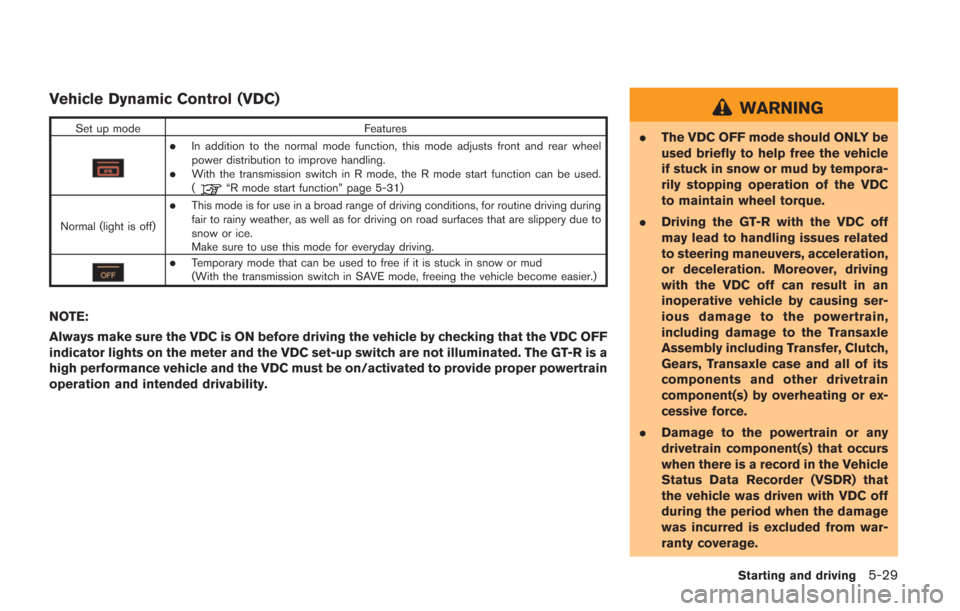
Vehicle Dynamic Control (VDC)
Set up modeFeatures
.In addition to the normal mode function, this mode adjusts front and rear wheel
power distribution to improve handling.
.With the transmission switch in R mode, the R mode start function can be used.
(“R mode start function” page 5-31)
Normal (light is off)
.This mode is for use in a broad range of driving conditions, for routine driving during
fair to rainy weather, as well as for driving on road surfaces that are slippery due to
snow or ice.
Make sure to use this mode for everyday driving.
.Temporary mode that can be used to free if it is stuck in snow or mud
(With the transmission switch in SAVE mode, freeing the vehicle become easier.)
NOTE:
Always make sure the VDC is ON before driving the vehicle by checking that the VDC OFF
indicator lights on the meter and the VDC set-up switch are not illuminated. The GT-R is a
high performance vehicle and the VDC must be on/activated to provide proper powertrain
operation and intended drivability.
WARNING
. The VDC OFF mode should ONLY be
used briefly to help free the vehicle
if stuck in snow or mud by tempora-
rily stopping operation of the VDC
to maintain wheel torque.
. Driving the GT-R with the VDC off
may lead to handling issues related
to steering maneuvers, acceleration,
or deceleration. Moreover, driving
with the VDC off can result in an
inoperative vehicle by causing ser-
ious damage to the powertrain,
including damage to the Transaxle
Assembly including Transfer, Clutch,
Gears, Transaxle case and all of its
components and other drivetrain
component(s) by overheating or ex-
cessive force.
. Damage to the powertrain or any
drivetrain component(s) that occurs
when there is a record in the Vehicle
Status Data Recorder (VSDR) that
the vehicle was driven with VDC off
during the period when the damage
was incurred is excluded from war-
ranty coverage.
Starting and driving5-29
Page 227 of 354
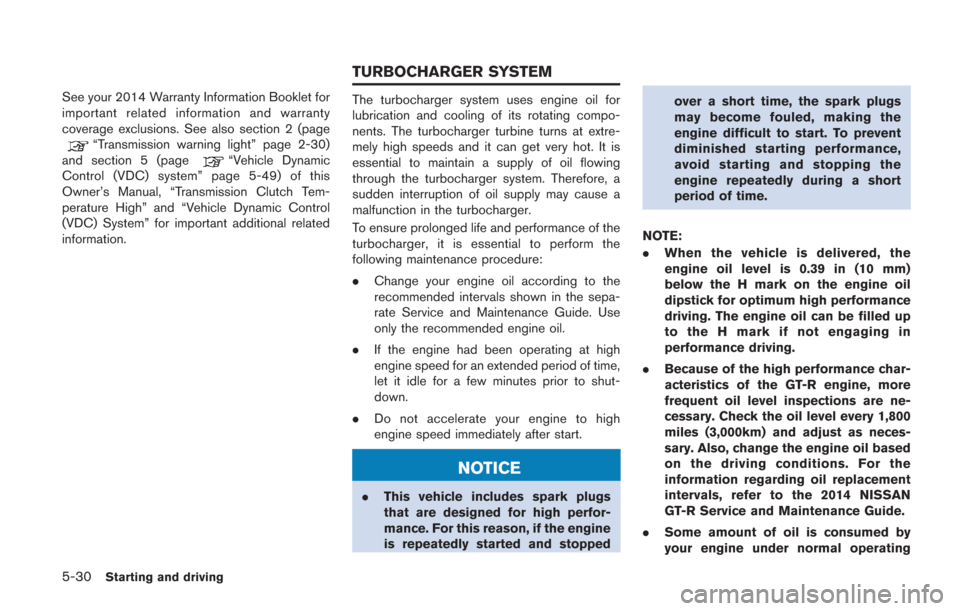
5-30Starting and driving
See your 2014 Warranty Information Booklet for
important related information and warranty
coverage exclusions. See also section 2 (page
“Transmission warning light” page 2-30)
and section 5 (page“Vehicle Dynamic
Control (VDC) system” page 5-49) of this
Owner’s Manual, “Transmission Clutch Tem-
perature High” and “Vehicle Dynamic Control
(VDC) System” for important additional related
information.
The turbocharger system uses engine oil for
lubrication and cooling of its rotating compo-
nents. The turbocharger turbine turns at extre-
mely high speeds and it can get very hot. It is
essential to maintain a supply of oil flowing
through the turbocharger system. Therefore, a
sudden interruption of oil supply may cause a
malfunction in the turbocharger.
To ensure prolonged life and performance of the
turbocharger, it is essential to perform the
following maintenance procedure:
. Change your engine oil according to the
recommended intervals shown in the sepa-
rate Service and Maintenance Guide. Use
only the recommended engine oil.
. If the engine had been operating at high
engine speed for an extended period of time,
let it idle for a few minutes prior to shut-
down.
. Do not accelerate your engine to high
engine speed immediately after start.
NOTICE
.This vehicle includes spark plugs
that are designed for high perfor-
mance. For this reason, if the engine
is repeatedly started and stopped over a short time, the spark plugs
may become fouled, making the
engine difficult to start. To prevent
diminished starting performance,
avoid starting and stopping the
engine repeatedly during a short
period of time.
NOTE:
. When the vehicle is delivered, the
engine oil level is 0.39 in (10 mm)
below the H mark on the engine oil
dipstick for optimum high performance
driving. The engine oil can be filled up
to the H mark if not engaging in
performance driving.
. Because of the high performance char-
acteristics of the GT-R engine, more
frequent oil level inspections are ne-
cessary. Check the oil level every 1,800
miles (3,000km) and adjust as neces-
sary. Also, change the engine oil based
on the driving conditions. For the
information regarding oil replacement
intervals, refer to the 2014 NISSAN
GT-R Service and Maintenance Guide.
. Some amount of oil is consumed by
your engine under normal operating
TURBOCHARGER SYSTEM